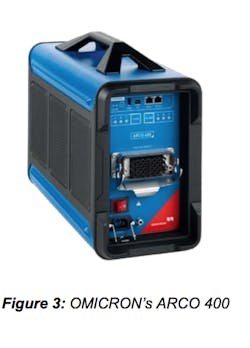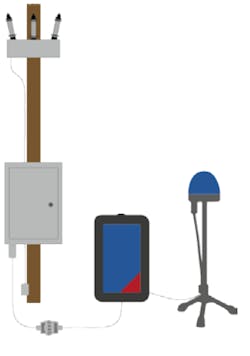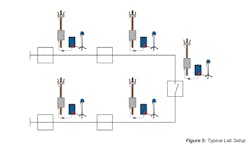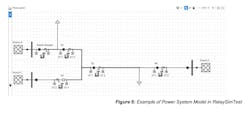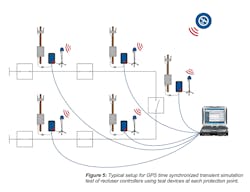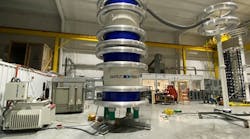With an ever-growing demand for a more reliable distribution grid, utilities are constantly looking for possibilities to optimize their distribution networks through the implementation of distribution automation. One of the methods used to improve the network and reduce permanent outages is by using pole-mounted reclosers due to their wide range of functionality.
With the introduction of built-in voltage sensing on both its source and load side, automation can easily be achieved by local built-in logic to isolate a faulted section, and closing in a tie recloser to supply power to customers from an alternate source. Automation schemes using coordinated protection functions provide an easy and low-cost solution for improving reliability, however, the process of isolation and service restoration can take up to several minutes. For critical feeder lines where long temporary outages are not acceptable, reclosers equipped with high-speed peer-to-peer communication provide possibilities to locate, isolate and restore power to unfaulted sections within seconds or faster.
With the American Recovery and Reinvestment Act of 2009 providing $4.5 billion to the U.S. Department of Energy to modernize the electric power grid, most the funded smart grid projects include communication assisted distribution automation. [1] In order to put such projects into operation, utilities often rely on manufacturers to design and implement the automation scheme. Thorough testing of the entire scheme prior to installation is critical to ensure that the switching logic works as desired for a multitude of fault scenarios, which may affect the network, and that the communication equipment can support the resulting network traffic. The testing process is integral for the verification of the system, but can also be extremely complex, labor-intensive and time-consuming.
This paper suggests an easy-to-apply method for testing of any distribution automation network that will significantly reduce testing time while covering parameters, which can verify correct operation of distributed automation schemes, which are typically not included in routine conventional testing.
Feeder Automation Configuration Example
There are different many possibilities for automating feeders using reclosers. A commonly used method is to connect two feeders at an interconnection point using a normally open recloser as shown in Figure 1. While the number of reclosers used in the scheme may vary, this example provides a general idea of the concept.
If a fault occurs as shown in Figure 2, R3 must trip first to interrupt current flowing into the fault. To isolate the faulted section, R4 should open next. A check should then occur to see if the feeder supplied by Sub 2 can supply the additional load between R4 and R5. If the load can be supplied, the normally open R5 will close in, restoring power to customers who would otherwise be left out of service.
Now that power is restored to customers between R4 and R5, R3 will try to reclose to check if the fault was only of temporary nature.
When purely based on voltage logic, this scheme will typically take a minute or more to restore power to non-faulted sections, which may not be acceptable for critical feeder lines. This isolation and reconfiguration process can be significantly improved by using communication to or between the reclosers in the field. In case of a fault, the recloser could then quickly send an open or closing signal to downstream and tie reclosers.
Communication Platforms and Performance
The performance of the automation scheme greatly depends on the communication platform used. A wired network using fiber-optic cables is one of the fastest solutions available, since it offers a high bandwidth and low latency. Implementing schemes with new fiber-optic networks can be very expensive, and considerations need to be made for the number of protection devices and the distances between protection devices.
An alternative solution would be to use wireless networks, which can be easily established and expanded and can fulfill both bandwidth and latency requirements. Utilities often have a choice to use public or private wireless networks. When deciding whether to implement a public or a private network for communication, a number of factors are considered; cost certainly is one of them, but service availability and coverage are very important to consider. Aside from the communication platform, the performance of the scheme also depends on the number of devices connected, the communication distance and certainly, the communication technology used.
Testing Protection Functions
If the protection of the scheme is not based on communication or distributed logic, testing the protective functions of the recloser control could be performed with minimal effort via secondary injection testing for individual recloser controls. OMICRON recommends using the ARCO 400 400 test set, which can be universally connected to the control cable interface of any recloser control with short recloser-specific adapters. The device simulates the recloser with up to six voltages and enables three-phase testing of the controller in both lab and field environments.
Testing Distribution Automation Schemes
When testing a distribution scheme with communication and distributed logic, test needs to include all the protection devices in the scheme to verify the correct functionality. A distribution automation scheme can be implemented with hundreds of lines of custom logic code in the recloser control and/or a programmable automation controller. Prior to a scheme being deployed in the field, it needs to be thoroughly tested to ensure that the scheme operates as expected, especially once it is put into operation. When a fault occurs, the distribution automation scheme needs to identify; the location of the fault, and the best way to clear the fault, and restoration of the unfaulted line segments, through various switching sequences. These switching sequences will also need to be tested to fully verify the functionality of the scheme.
Typical Scheme Tests in a Lab
For a lab test of a distribution automation scheme, all devices are set up in a test environment. These tests are typically performed as a proof of concept for new projects, or acceptance testing of a scheme prior to installation in the field. Using secondary injection test devices connected to each recloser control, various pre-programmed test sequences can then be executed to test the logic and the communication, which are essential to the scheme.
Scheme testing can be complex and may require weeks to complete. For every fault scenario, load and fault values for each operating state must be calculated for every recloser in the scheme in order to simulate realistic faults. For the execution of each test case, vocal coordination to turn injection from each test device on and off at designated times to simulate each step of the test case is required. Any mistakes or miscoordination amongst the test personnel would result in an inaccurate test. After execution, the results from each location must then be collected, merged, and assessed. If any issues are discovered, the automation logic would need to be adapted to address the problems.
Figure 4: ARCO Connected to Recloser Control
To synchronously test a scheme involving several reclosers, a single test device can be assigned for each recloser location, which then requires synchronization (e.g., via a GPS or IRIG-B signal).
Shortcomings of a Typical Lab Test
The previously described method has proven to work well for lab testing, however, it comes with several disadvantages: The expected test values have to be calculated and programmed into a sequence for every single test device, which is a very time-consuming process. After running the test, additional time must be spent comparing the time stamps of each test result from each different testing device. All this effort can represent additional complications.
Besides the disadvantages described, there are two factors which can influence the performance or even the basic function of the scheme. which are not considered. When distribution automation schemes are installed in the field, distances between the individual reclosers can be much farther than when testing in a lab environment. Longer communication distances with possibly weak communication links and waveforms of faults that are different to those static fault values can drastically affect the operation and testing of the scheme.
Influence of Communication Equipment
The communication equipment used in automated high-speed distribution automation schemes are a critical component in automated schemes. The performance of the scheme greatly depends on the selected communication media, which defines how fast and how much information can be transmitted from one device to another. Only certain technologies provide enough bandwidth, security, and reliability to wirelessly transmit (e.g., an IEC61850 GOOSE message). Other commonly used wireless transmitting technologies nowadays are WiMAX, LTE or 4G [2].
With greater distances in field installations, the transmitting and receiving functions can be affected, and in the case of a weak link or overflow on the communication channels, the automated scheme might fail [2]. For this reason, synchronized injection testing into all devices in the field is recommended to test the scheme under real-life conditions.
Transient Waveforms
A test under real-life conditions requires the test values to match those of a real fault as closely as possible. With conventional testing methods, static fault values are typically applied, then the resulting reaction from the recloser control is measured. Under realistic conditions, a DC offset is present in cases of a fault, and depending on the algorithms of the recloser control, one device in the scheme might detect the fault faster than another. To determine the real performance of the scheme it is beneficial to test with transient signals.
New Approach for Scheme Testing in the Field
Using a new software called RelaySimTest, distribution automation schemes can now be tested in the lab or field, all while being remotely controlled from a single PC. In addition to addressing the issues described previously, this solution greatly reduces the testing time while providing comprehensive reporting and troubleshooting possibilities.
In RelaySimTest, the power system under test can be modeled in a single line diagram editor, and devices such as reclosers and circuit breakers can be placed in the network. Infeeds are defined by entering the Source-Impedance-Ratio (SIR), the line data calculated by using line length and impedance, and loads in the network specified using active and reactive power data. Using this information, the software can calculate the resulting load and fault values for any user-defined test case.
The behavior of the circuit breakers and/or reclosers should be defined within the simulation software. If the circuit breaker and/or recloser opening and closing times are known, or has been previously measured using a breaker timing test device, the software allows for the input of those times, which are taken into consideration to ensure a more realistic test. The ARCO 400, as well as other secondary injection test devices, have a built-in circuit breaker simulator, which can be extremely beneficial for testing purposes. Using the binary outputs of the test device, the 52a and 52b contacts can be simulated, which does not require the circuit breaker or recloser to be connected during the test.
For a lab or field test a single test set needs to be connected to each recloser control or relay to inject the appropriate currents and voltages inputs, binary inputs (52a/b), as well as receive the resulting binary outputs (trip/close commands). However, when performing a field test, protection points can be located several miles away from each other. The system must use either an existing communication network, or use an external cloud service with remote connection. In this case, all the testing devices need to be synchronized to GPS for a time-synchronized injection.
Once GPS synchronization is established, all test devices in the scheme can communicate with each other, as well as with the associated PC running the simulation software over the network. A requirement for this PC is that it must be given access to the network to establish communication with all the test devices. To synchronize all test devices at each protection point, individual GPS antennas are used.
For each test case, a fault can be defined within the RelaySimTest single line diagram representation of the scheme; the software then calculates the resulting fault values for each device at each location. When the test is executed, RelaySimTest proceeds to send the calculated test values into all test sets. Upon receiving all of the test values at the test devices, the injection begins synchronously.
While a closed-loop test would be ideal; meaning that after a device issued a close or open command the software would calculate new values taking in to account the changed values after e.g. a breaker opening. With a distributed test, this is not possible, but RelaySimTest offers the functionality of a so-called “iterative closed-loop test”. When this mode is enabled, the software would run a first test, and once a device under test in the scheme reacts, the software recalculates the test values with taking this operation into account. It is assumed that a device under test will always react in the same time if the same test values are applied.
After resetting the scheme, the test is then repeated as the second iteration. RelaySimTest automatically repeats the calculations from the previous operations from the first iteration into account. This iterative process will continue to reset and run until there are no more reactions of the system under test. This is typically the case once the fault is isolated and power is restored to segments of the network which are not affected by the fault.
Using this method of test. the correct switching behavior of the scheme can be assessed, and it is immediately clear if the communication equipment can handle the amount of data once the equipment is installed in the field. Thanks to transient test signals, the overall performance of the automation sequence can be measured and assessed. Furthermore, it can be determined if corrective measures to improve the performance of the system need to be implemented.
The method and testing process described in this paper is easily applied and allows communication-based automated distribution schemes to be performed in a lab or field environment to verify both the switching logic, communication equipment, and the communication network’s ability to handle the data traffic. By using transient test values in addition, the actual performance of the scheme can be evaluated, and it could also be used to compare different communication technologies. By using the iterative closed-loop approach the switching operations don’t need to be defined prior to the test. The software will learn the behavior of the scheme for a certain fault, and the engineer is only required to assess if the switching operations were performed correctly by the devices under test.
References
[1] U.S. Recovery Act: SmartGrid Projects (https://www.smartgrid.gov/recovery_act/)
[2] Newton Evans Survey (http://www.newton-evans.com/distribution-automation-communications-forfeeder-automation/)
[3] ARCO 400 – The future of recloser testing (https://www.youtube.com/watch?v=9h2yQ2sJeUo)



